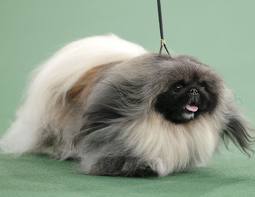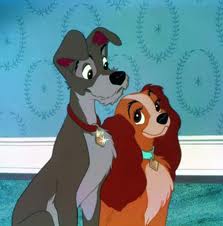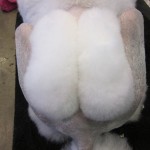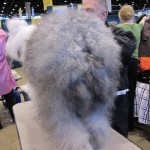A couple of weeks ago, Nick and I found the TV offerings particularly desolate and we struggled to stitch together a reasonable combination of a primary TV show and a toggling alternative. After much flailing about, we hit upon the unusual combination of the Westminster Dog Show and a documentary about snipers. The sniper show was interesting enough – a decorated sniper calmly explained that he had taken out an Iraqi “insurgent” at 500 yards with a single bullet to the fatal “T” zone that encompassed the victim’s eyes down to his throat. The show even showed an x-ray demonstrating a bullet entering the brainstem. More than once the sniper commented, “He was dead before he hit the ground,” suggesting that such a clean kill was a particular point of pride – although the insurgent was dead he did not suffer. The whole thing was a bit too grisly, but what can you expect when the Military Channel is your last resort toggle option?
Ah, the relative peace of theWestminsterdog show, where we lucked into the final “Best in Show” event. It is easy to snicker at the handlers running along their over-groomed dogs. And then there was the mysterious judge, a women dressed in a odd metallic-looking suit, who momentarily stopped by each dog, occasionally looked at the teeth, sometimes asking the owner to lift the tail. And then kaboom! She indicated that this ridiculous looking Pekinese (?Beijingese?) was the Best in Show, beating out the gorgeous Irish setter I was rooting for. The announcer was Mary Carillo, repurposed from her usual role as tennis commentator but she was unable to provide any insight. This was an entirely subjective contest, so it was hard to believe that such a momentous decision could be entrusted to a single individual. Like Olympic figure skating or diving, shouldn’t there have been a panel of judges holding up their ranking cards? Then maybe Mary Carillo could discuss the possible collusion of the Eastern bloc judges.
the owner to lift the tail. And then kaboom! She indicated that this ridiculous looking Pekinese (?Beijingese?) was the Best in Show, beating out the gorgeous Irish setter I was rooting for. The announcer was Mary Carillo, repurposed from her usual role as tennis commentator but she was unable to provide any insight. This was an entirely subjective contest, so it was hard to believe that such a momentous decision could be entrusted to a single individual. Like Olympic figure skating or diving, shouldn’t there have been a panel of judges holding up their ranking cards? Then maybe Mary Carillo could discuss the possible collusion of the Eastern bloc judges.
But I left the vagaries of dog show judging to those immersed in this subculture and instead focused on the amazing diversity of dog breeds. There are about 150 breeds that compete in dog shows, but there are many other more home-brewed breeds, like our two cock-a-poos, which are an intentional cross between a cocker spaniel and poodle. Breeds range in size from the 2 pound tea cup dogs that double as fashion accessories, to the English mastiff that can weigh over 300 pounds. This diversity is all derived from the initial enterprising wolf who decided to be sociable and throw in his lot with humans. Ooga Magook and our cave dwelling ancestors discovered that they could train dogs to protect the home and do some useful chores. Even better, with a little genetic engineering, they could tailor-make breeds for specific tasks.
The dogs eagerly accepted the relative security of human cohabitation, and reference books say that the dogs took the initiative and “self-domesticated,” but I wonder if they truly understood the risks. They avoided the harsh cruelty of nature, but then risked the random cruelty of humans. This thorny theme is well addressed in the Disney movie, “Lady and the Tramp.” Tramp chafes at the thought of a collar and a license, and enjoys  his life as the carousing bachelor about town with an “eye for the well-turned paw.” However, he is eventually picked up by the dog catcher and threatened with euthanasia. How much freedom is Tramp willing to sacrifice to ensure security? Eventually, he settles down with Lady and in the final scene he is wearing a collar. Tramp also sniffs in disdain at coddled pure breeds. Where is Tramp on that greasy slope of opportunity vs. sell out?
his life as the carousing bachelor about town with an “eye for the well-turned paw.” However, he is eventually picked up by the dog catcher and threatened with euthanasia. How much freedom is Tramp willing to sacrifice to ensure security? Eventually, he settles down with Lady and in the final scene he is wearing a collar. Tramp also sniffs in disdain at coddled pure breeds. Where is Tramp on that greasy slope of opportunity vs. sell out?
Dogs lost the daily rigors of scrounging food to eat, but they then lost one of the most basic freedoms – the freedom to choose their mating partner. Humans manufactured breeds with short legs for digging out rodents, dogs with exquisite noses for hunting, water dogs, herding dogs, they were all created by focused human efforts. In this process, humans are engineers seeking perfection, while Mother Nature is basically a tinkerer where “just good enough” is an evolutionary endpoint. Left to random breeding, dogs will quickly revert to a basic generic dog – actually a dog that looks quite a bit like Tramp.
Watching the Westminster Dog Show reminded me of when we used to take the kids to the dog show, so I was pleased to discover that the American Kennel Club was sponsoring their “Cluster of Dogs” show last weekend. I decided to witness this great genetic experiment first hand. (I will admit that the bizarre culture of dog breeders and handlers was also intriguing.) It was just as I remembered – rows and rows of dogs in cramped crates, or sitting on their handlers’ laps being continuously petted or standing on a table immobilized with a noose to permit endless over-the-top grooming. The poodle cuts are famously pretentious, but supposedly have some basis in their original role as water dogs. The long hair around the chest keeps the vital organs warm while in water, while the shaved legs facilitate a vigorous dog-paddle. Those two fur patches on their back supposedly protect the kidneys, but actually look more like an outline of a pair of buttocks. Some dogs look blinded by their grooming, and for some dogs, I
Some dogs look blinded by their grooming, and for some dogs, I  had trouble distinguishing the butt from the face. One of the groomers was wearing a T-shirt that said, “Groomers do it on a table.” I saw a few people kissing their dogs full on the lips. To me, it looked like the dogs had a miserable life – valued only for some contrived sense of beauty as opposed to any innate dogginess. An attractive but empty-headed woman is called a bimbo; I think that the male equivalent is the phrase “Oh, he’s just a show dog.” Tramp would have been appalled at security vs. freedom trade-off for show dogs.
had trouble distinguishing the butt from the face. One of the groomers was wearing a T-shirt that said, “Groomers do it on a table.” I saw a few people kissing their dogs full on the lips. To me, it looked like the dogs had a miserable life – valued only for some contrived sense of beauty as opposed to any innate dogginess. An attractive but empty-headed woman is called a bimbo; I think that the male equivalent is the phrase “Oh, he’s just a show dog.” Tramp would have been appalled at security vs. freedom trade-off for show dogs.
I wandered over to the judging ring and picked up a brochure that explained the show. I immediately noticed that dog breeders have no compunction about using the word “bitch” freely and often. Before I ever say that word out loud I glance around to make sure that I will not offend anyone. When did bitch become a bad word? According to dictionary.com, this connotation emerged around 1400 and now we routinely use bitch as a noun, verb and adverb to describe unpleasant people, situations and behavior. In contemporary culture, something so negative can also acquire a positive meaning. For example, I have heard sports announcements describe a virtuoso athletic achievement as “sick,” such as “that catch in the endzone was just sick.” Same thing happened to bitch. In 1969, you might have heard, “I met this righteous babe at Woodstock and we had a bitchin’ time.”
I watched one judging session of identical looking golden retrievers. Every time the dog moved the handler would give him a little treat. (I even saw one handler eating one of the treats herself.) According to my brochure this was called “bitch baiting,” a term that seemed at the very least lewd and potentially illegal, but here at the dog show, the word “bitch” comes without any cultural baggage. While the dogs waited to parade around, I noticed one handler had stuffed a brush into his belt like a gun. He quickly pulled it out for one last grooming effort. The judge seemed to take a perfunctory glance at each dog and then, with no announcement, no play by play commentary, the judge indicated a winner, a process that seemed as arbitrary as refs calling basketball fouls.
I finished my visit with a tour of the vendors where there were many “only-in-America” moments – glittery dog clothes, custom made dog beds to match a master bedroom, canine massage and a doggie day spa called “Paradise 4 Paws.” The spa was located next to the airport allowing for easy drop-off on the way to a vacation. Dogs enjoy a bone shaped splash pool, “overnight suites” or “slumber party lounges.” Owners can also check up on their pets with web-cams.
to the airport allowing for easy drop-off on the way to a vacation. Dogs enjoy a bone shaped splash pool, “overnight suites” or “slumber party lounges.” Owners can also check up on their pets with web-cams.
Other venders specialized in extensive grooming supplies. I asked one vendor, “Do dogs wear make up?”
He looked at me as if he had just heard the stupidest question in the world. “Well hell yes,” he said. “Dogs have blemishes you know.”
“And what about dying their hair?” I asked.
He grimaced, “Well I don’t approve of it, but what can I do? Sure I sell dye.”
There were all sorts of doggie treats, such as chew toys designed to look like a hot dog, easily digestible elk antlers, knee caps from some slaughtered animal, and hooves filled with a jaundiced looking liver concoction. There was an endless array of different nutritional supplements and organic food – the cost of a can probably exceeded the daily budget for a school lunch program. I then realized that the dogs were better groomed and had a better diet that those of the handlers. I walked by one woman who was meticulously creating a razor sharp part in her Pekinese. She was using a small needle to rearrange individual hairs. In contrast, her hair was a jumbled mess. It was now lunchtime and many of the handlers were eating from plastic containers on their laps. The typical lunch was a mountain of nacho chips smothered in too-bright yellow cheesiness. As the handler dipped and crunched, neighboring handlers were madly brushing dogs or wielding industrial hair driers. I felt that I was standing in a falling veil of dander and hair, and that the puddles of nacho cheese were functioning as gooey and edible lint traps. It was time to go.
When I got back home, our two dogs greeted me warmly. What was their trade-off? Our cock-a-poos were specifically bred to be hypo-allergenic and non shedding; both were immediately “fixed.” Ouch. We feed them exactly the same meal twice a day. We would feed them more scraps except that their stomachs can no longer handle any variety. Two strikes against. On the plus side, they have never been in a crate. Nick faithfully takes them for two 45 minute walks a day where they enthusiastically dig for voles. And they really get their ancient wolf going when they bark in response to the baying coyotes in the adjacent prairie. All in all, these dogs lucked into a trade-off that even Tramp would applaud.
The missing words in the following poem are anagrams (i.e. share the same letters like spot, post, stop) and the number of asterisks indicates the number of letters. Your job is to solve the missing words based on the above rules and the context of the poem. Scroll down for answers.
Ma Nature has created ****** of every shape and kind,
But she probably only had a single generic dog in mind.
Humans wanted better; they thought a sensitive nose was an important asset,
So they started a program of genetic engineering and invented a super sniffing ******.
Dogs may enjoy the security of domestication but some have paid a steep price,
It they knew the risk of the ****** of human cruelty they might have thought twice.
Even top dogs who are considered ** **** in show might not want to celebrate.
Humans control every little thing, especially who, when and if they can ever mate.
*
*
*
*
*
*
*
*
Beasts, basset, basest, as best
Follow Liza Blue on:Share:
